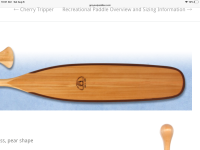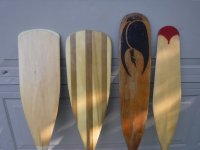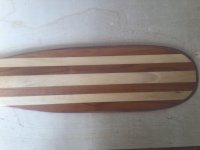-
Happy Opening of the Maine Turnpike (1947)! 🛣️🦞🌲
You are using an out of date browser. It may not display this or other websites correctly.
You should upgrade or use an alternative browser.
You should upgrade or use an alternative browser.
Epoxy filler for paddle edging
- Thread starter Rubbaboo
- Start date
I use phenolic sheet cut to fit for most of my paddle tip protection needs. I epoxy the tips on with Cabosil thickened epoxy from RAKA, I do not use any West System products.
The last batch of paddles that I built, I used 2 oz cloth on both blade faces, and also wrapped the 2 oz around the edges, but not around the phenolic tips.
I have some older paddles that I built 25 and 35 years ago, and while some of the edges have worn quite a bit, those phenolic tips are still in great shape.
The last batch of paddles that I built, I used 2 oz cloth on both blade faces, and also wrapped the 2 oz around the edges, but not around the phenolic tips.
I have some older paddles that I built 25 and 35 years ago, and while some of the edges have worn quite a bit, those phenolic tips are still in great shape.
I used a mix of West system 105 and G-flex, and cabosil to thicken on one Sugar Island paddle 3/16" past paddle edge, built up another tip with a higher proportion of g-flex in the mix and greater volume on a modified otter tail, polyester cord and g-flex on another Sugar Island, another solid cherry otter tail has a maple spline at the tip and has held up well over 25 years. Both Sugar Island paddles edges grooved to provide key for epoxy and covered with 2 oz cloth, otter tails simply coated with several coats of oil/solvent/varnish. Next time I cover blades with cloth and integrate tip guards I will make the blades considerably thinner for better balance.
Basswood is great material for prototypes, light and very easy to work. would seal end grain with clear epoxy mix before casting with coloured mix next time.
Would be curious to try phenolic sheet - argument for this would be less fuss with forming epoxy? Softer? I thought that West System 105 on its own would be too brittle, adding the g-flex definitely softened the end result.
Basswood is great material for prototypes, light and very easy to work. would seal end grain with clear epoxy mix before casting with coloured mix next time.
Would be curious to try phenolic sheet - argument for this would be less fuss with forming epoxy? Softer? I thought that West System 105 on its own would be too brittle, adding the g-flex definitely softened the end result.
Attachments
Last edited:
I hadn’t thought of this til just now, but a nearly indestructible tip could be fashioned from an epoxy/Dynel layup.
Strength is generally not an issue, especially if the entire blade and tip will be laminated in glass/favorite fiber.
A Dynel tip would likely outlive any paddle, and could be recycled time after time for generations!!
Which gets me wondering if any Dynel sheet is commercially available or if I just came up with yet another cottage industry
Strength is generally not an issue, especially if the entire blade and tip will be laminated in glass/favorite fiber.
A Dynel tip would likely outlive any paddle, and could be recycled time after time for generations!!
Which gets me wondering if any Dynel sheet is commercially available or if I just came up with yet another cottage industry
a nearly indestructible tip could be fashioned from an epoxy/Dynel layup.
The Sawyer Ranger X paddle has a "Full perimeter Dynel ToughEdge".
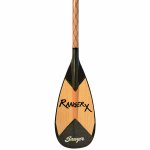
Wow! That's not a bad price either!
The Sawyer Ranger X paddle has a "Full perimeter Dynel ToughEdge".
Wow! That's not a bad price either!
The much lighter weight (20 oz.) Sawyer Voyager also has the same "Dynel ToughEdge" around the perimeter.
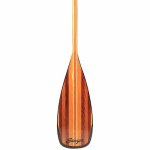
Makes sense, good call, it’s a laminated basswood/alder paddle I’m working on, it’s a beefed up but lighter weight tripper, bit of a paradox I’m afraid. Both pretty porous woods. It’ll get glassed too. Here’s where I’m at:Basswood is great material for prototypes, light and very easy to work. would seal end grain with clear epoxy mix before casting with coloured mix next time.
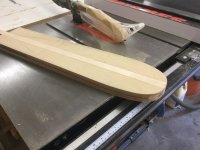
Plan is to spread the epoxy into the grove, hopefully without any voids, and then I’ll cut out the throat of the paddle using my pattern and router for a smooth transition, shape down to the epoxy edge and voila
Had thought about usingt West 406 colloidal silica which I think? is like cabosil but it turns the epoxy white, according to its description it’s properties do make it the most suitable.
Right now Im leaning towards the 405, and I like the gflex suggestion.
The Sawyer Ranger X paddle has a "Full perimeter Dynel ToughEdge".
Neat paddle, theres probably a few proprietary trade secrets involved in making them! Its interesting trying to figure out how theyre put together.
I used West System 406 colloidal silica...but referred to it as cabosil - anyone know the difference if any?
Curious to know the filler used to get the colour in these edge protectors.
Ranger X looks like serious overkill. There does seem to be a market for anything carbon.
How about a dynel spline cut into the tip, providing cross grain strengthening and impact resistance...
Edge guards still seem unnecessary for anything other than whitewater paddles.
Cloth and resin for laminated blades makes sense to support the different layers and provide strength to a much thinner blade than possible with wide single plank blades.
Curious to know the filler used to get the colour in these edge protectors.
Ranger X looks like serious overkill. There does seem to be a market for anything carbon.
How about a dynel spline cut into the tip, providing cross grain strengthening and impact resistance...
Edge guards still seem unnecessary for anything other than whitewater paddles.
Cloth and resin for laminated blades makes sense to support the different layers and provide strength to a much thinner blade than possible with wide single plank blades.
in the big www I've found this
hopfuly it will help you to solve your Problem.
regards
michael
hopfuly it will help you to solve your Problem.
regards
michael
I hadn’t thought of this til just now, but a nearly indestructible tip could be fashioned from an epoxy/Dynel layup.
Strength is generally not an issue, especially if the entire blade and tip will be laminated in glass/favorite fiber.
A Dynel tip would likely outlive any paddle, and could be recycled time after time for generations!!
Which gets me wondering if any Dynel sheet is commercially available or if I just came up with yet another cottage industry
I've wrapped the edge of a few carbon paddles with dynel cloth. It's ugly as all get out but it's effective.
I also used it on a wood paddle and that was much more attractive because I painted it when done.
Alan
I can see where a Dynel wrap would be ugly as can be…
I searched and cannot find any Dynel solid sheet stock, I believe it doesn’t exist.
A bunch of Dynel layers, some epoxy resin, a little vacuum and peel ply and BAM!! You’ve got extreme wear protection for paddle tips, edges, canoe stems, etc.
No different from phenolic sheet or G10 glass sheet.
I searched and cannot find any Dynel solid sheet stock, I believe it doesn’t exist.
A bunch of Dynel layers, some epoxy resin, a little vacuum and peel ply and BAM!! You’ve got extreme wear protection for paddle tips, edges, canoe stems, etc.
No different from phenolic sheet or G10 glass sheet.
I have some Dynel fabric someone can have. One could pull apart the weave and get threads if that is what you are looking for.
Jim
Or do as stripperguy suggests and laminate up some layers.
Jim
Or do as stripperguy suggests and laminate up some layers.
Similar threads
- Replies
- 8
- Views
- 671
- Replies
- 5
- Views
- 609

